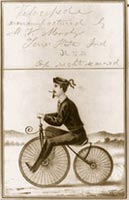ECONOMICS AND TRADE | Achieving growth through open markets
22 April 2008
Why Protecting Intellectual Property Rights Matters
Culture, society, and innovation all depend on IPR

(The following article is taken from the U.S. Department of State publication, Focus on Intellectual Property Rights.)
Why Protecting Intellectual Property Rights Matters
By E. Anthony Wayne
Intellectual property issues are getting more and more attention these days. Unfortunately, far too often the issues are framed in such a way as to highlight controversy and polarize debate. In fact, there is much about intellectual property protection on which everyone can agree.
To arrive at a fuller understanding of the issue, it is worth spending some time considering how intellectual property rights (IPR) developed and what role they play in achieving widely shared objectives. What comes out of such an examination is the conclusion that intellectual property protection is a vital part of social, cultural, and economic development. Protection of intellectual property rights alone will not necessarily bring about this development. But it is hard to imagine that a country could ever reach these goals in the absence of such protection.
COPYRIGHTS AND CULTURE
We can credit 17th century England with the concept of a "copy right," a law that protects the creative products of authors, artists, singers, and, to reflect developments since the 1600s, filmmakers and software developers. This concept even has been enshrined in the U.S. Constitution, whose Article I, Section 8, Clause 8 reads, "the Congress shall have power ... to promote the progress of science and useful arts, by securing for limited times to authors and inventors the exclusive right to their respective writings and discoveries."
The essential idea behind a copyright is simple: Artists and creators should be able to enjoy the fruits of their labor for a specified time period, after which the material becomes available for public use. Society benefits because this incentive to create will yield a rich and varied cultural menu for its citizens. Indeed, one can say that copyright protection is a necessary ingredient for ensuring cultural wealth in our societies.
But if copyright protection is important for reaching cultural objectives, then it is equally true that the theft of these copyrighted goods – that is, the pirating of cultural works – is a threat to the creative sectors in our societies. Many international institutions, such as the World Bank, the World Intellectual Property Organization (WIPO), and even the United Nations Educational, Scientific, and Cultural Organization (UNESCO), recognize this link. In fact, if you visit UNESCO's web site, you will find an entire section devoted to the issue and a list of programs and publications that explain the benefits of copyright to educational, scientific, and cultural policies and provide help in finding ways to fight piracy.
While there has been much press play recently regarding on-line downloading of music and movies in developed countries like the United States, in fact it is in the developing world that much of the serious damage is being done. Many new musical voices, new authors, and new stories on film around the world have never been made available, simply because the incentives were not there for these artists to take a risk. They have known that whatever they produce will be immediately pirated – stolen – and they will not be provided the means to develop their talent.
This is not an abstract argument: It has happened on all continents. A good example is Hong Kong, where a thriving movie industry was so hurt by rampant piracy that, just a few years ago, observers were predicting it would disappear from the filmmaking map. Today, the industry is in better shape and moviegoers around the world enjoy new and exciting releases primarily because Hong Kong authorities took decisive action to combat the piracy problem. Studios in Bangladesh's "Dhaliwood" movie industry went on strike in March 2004 to protest the problem of piracy and demand action by the government. Similar developments have taken place in the world of music. Ethiopian musicians went on a seven-month strike in 2003 to press for better anti-piracy measures from the government. These artists all understood the importance of protecting their works from pirates.
PATENTS AND INNOVATION
Patents protect diverse inventions such as industrial designs, manufacturing processes, high-tech products, and molecular compounds. Like copyrights, patents were recognized in the U.S. Constitution. The Constitution granted Congress the powers to promote "the progress of science and useful arts" by providing inventors the limited but exclusive right to their "discoveries."

The concept of a patent is based on a trade-off. The inventor or innovator is given the exclusive right to make or use the invention for a limited period of time. In exchange, most countries' rules require the inventor to reveal the method behind the invention so that others may understand and learn from it. After the exclusive period of time elapses, anyone can make, use, or sell the invention. The inventor is granted an economic incentive to take risks and create; the public receives the benefit of the invention, as well as the inventor's knowledge for application in other uses.
Americans have always prided themselves in being a nation of innovators and inventors, willing to try something new, whether in industry or politics. As a result, patents are an important part of America's history. While most American schoolchildren probably do not know that patents are mentioned in the U.S. Constitution, many of them do know from their studies that one of the first patents issued was for Eli Whitney's cotton gin, a machine that was to have a critical influence on America's subsequent development.
But if this is true for America's experience, then it is just as true for other countries, including developing ones. Strong intellectual protection will not only encourage innovation, it will provide the level of confidence in an economy needed to attract foreign investment and spur technology transfer. This has been shown in a number of studies looking at the relationship between intellectual property, especially patents, and development. For example, a study highlighted in the World Bank's Global Economic Prospects Report 2002 found that "across the range of income levels, intellectual property rights are associated with greater trade and foreign direct investment flows, which in turn translate into faster rates of economic growth." Another 2002 World Bank publication, Development, Trade, and the WTO: A Handbook, noted a number of studies which, despite the lack of clear-cut results, did indicate that stronger patent regimes could: 1) lead to increased global trade; 2) attract more foreign direct investment; 3) lead to increased licensing of technologies to, and possibly more local production; and 4) contribute to higher growth rates.
A good example of this today can be found in Jordan, where strengthened patent protection has been linked to tangible economic benefits (see related article, "Jordan Benefits From Intellectual Property Reforms"). The International Intellectual Property Institute (IIPI) released a comprehensive report in August 2004 that looked at the establishment of globally competitive pharmaceutical and biomedical technology industries in Jordan. The report found that "Jordan's economy has benefited greatly from the recent adoption of better intellectual property protections," according to an IIPI release. The report noted that the strengthened intellectual property regime, particularly for patents, "spurred a new focus on research-based innovation for Jordanian pharmaceutical companies."
This was reflected in a jump in the health-service contributions to the Jordanian GDP from 2.8 percent in 1997 to 3.5 percent in 2001. Employment in the health-services sector has increased 52 percent since 1997. The report also found that "the pharmaceutical industry represents Jordan's second leading sector, and from 1999 to 2002, drug exports from local firms grew by 30 percent."
TRADEMARKS AND CONSUMER PROTECTION
A trademark is a word, phrase, symbol, or design, or a combination of words, phrases, symbols, or designs, that identifies and distinguishes the source of the goods of one party from those of others. They thus identify the producer of a product and serve as an indicator of quality. They also inform consumers where to seek recourse if the product fails. Some forms of trademarks have been around for thousands of years. Visitors to the Great Wall in China can still see the original producer's mark on some of its bricks. This mark allowed the emperors of that time to be assured of quality and, if needed, accountability.
This assurance of quality and accountability is completely lost when counterfeiters illegally use a trademark and deceive consumers with their goods. When many people think of counterfeit goods, they might bring to mind items such as fake Rolex watches, Zippo lighters, or Louis Vuitton handbags. The counterfeiting of these goods does inflict serious harm on legitimate companies, and it deprives governments of lost revenues. But counterfeiting of trademarks has another serious consequence. It can threaten the health and safety of the public.
The United States is not immune to this aspect of the counterfeiting epidemic. In testimony before the U.S. Senate Judiciary Committee in March 2004, U.S. Assistant Attorney General Christopher Wray provided examples of trademark violations. He noted that, in early 2004, a man from the state of Alabama pled guilty to 28 counts of counterfeiting and pesticide misbranding charges. He sold mislabeled and adulterated pesticides needed to control mosquitoes and, indirectly, West Nile virus, to municipalities and private businesses in a number of U.S. states. The defendant falsely identified the brand name of the pesticide, the manufacturer, and the active ingredients. In another case in 2002, the U.S. Department of Justice convicted a California man on federal charges involving a conspiracy to sell counterfeit baby formula. After exposing thousands in our most vulnerable population to counterfeit baby formula, the defendant fled to Canada in 1995. He was arrested there in 2001 and in 2002 was brought to the United States to stand trial.
Counterfeiting is a serious public health and safety threat in the developing world as well. One of the more tragic stories comes from China. In May 2004, the Associated Press reported from Beijing that 47 people had been accused of selling fake infant formula, an act that authorities said led to the deaths of dozens of children. According to the report, subsequent police raids uncovered thousands of bags of counterfeit milk powder with the labels of 45 different brands.
Counterfeit pharmaceuticals also have become a serious and deadly problem around the globe, especially in the developing world. No one knows this better than the head of Nigeria's National Agency for Food and Drug Administration and Control, Dorothy Akunyili. Her story, which was detailed in a May 2004 front-page article in the Wall Street Journal, seems to come straight from an action novel. Unfortunately, it is fact, not fiction. Her work to expose and combat counterfeit pharmaceuticals has led to assassination attempts against her life and arson attacks against her facilities. But she has bravely continued her work, spurred on in part by the personal experience of losing her sister, who died because of a counterfeit insulin injection. She, like many others, has understood the dangers and threats posed by counterfeiting.
IP AND SOCIETY
There is a common thread that runs through the above discussion of copyrights, patents, and trademarks. Promoting cultural development, fostering innovation and growth, and protecting public health and safety are all commonly held goals. We all want to live in societies where these values are cherished and fostered. In the current debate surrounding intellectual property, it is worth remembering the role of intellectual property protection in our daily lives.
The United States believes strongly in the value of protecting intellectual property rights, for the reasons outlined above and more, and stands ready to work with others to promote such protection.
[E. Anthony Wayne served as U.S. Assistant Secretary of State for Economic and Business Affairs.]